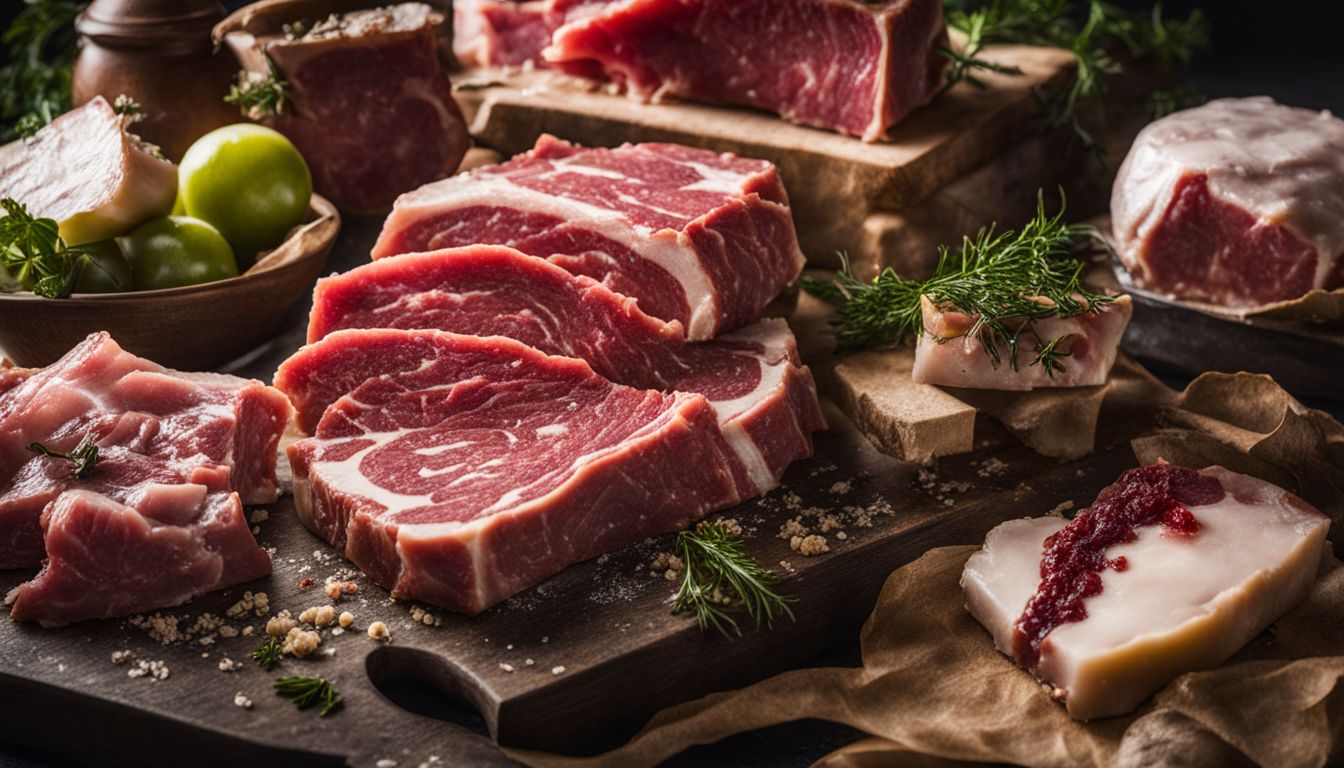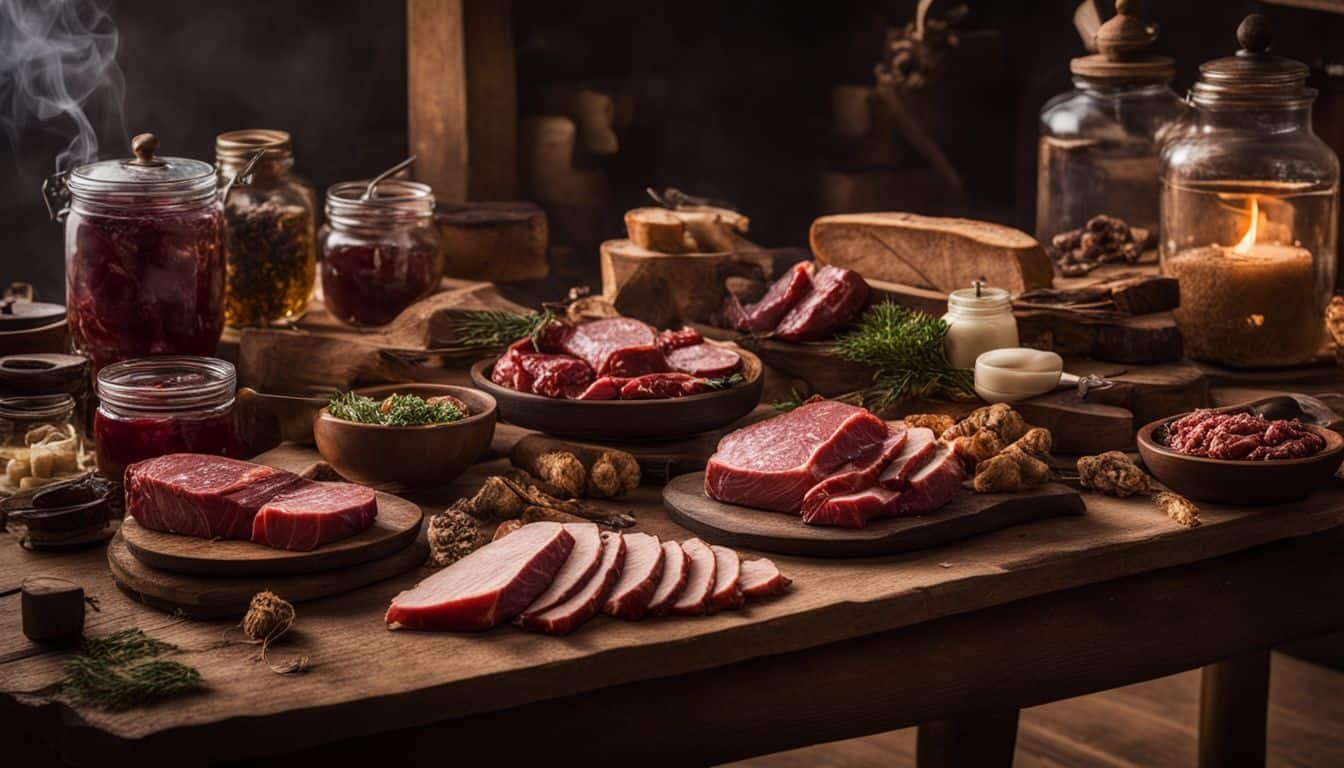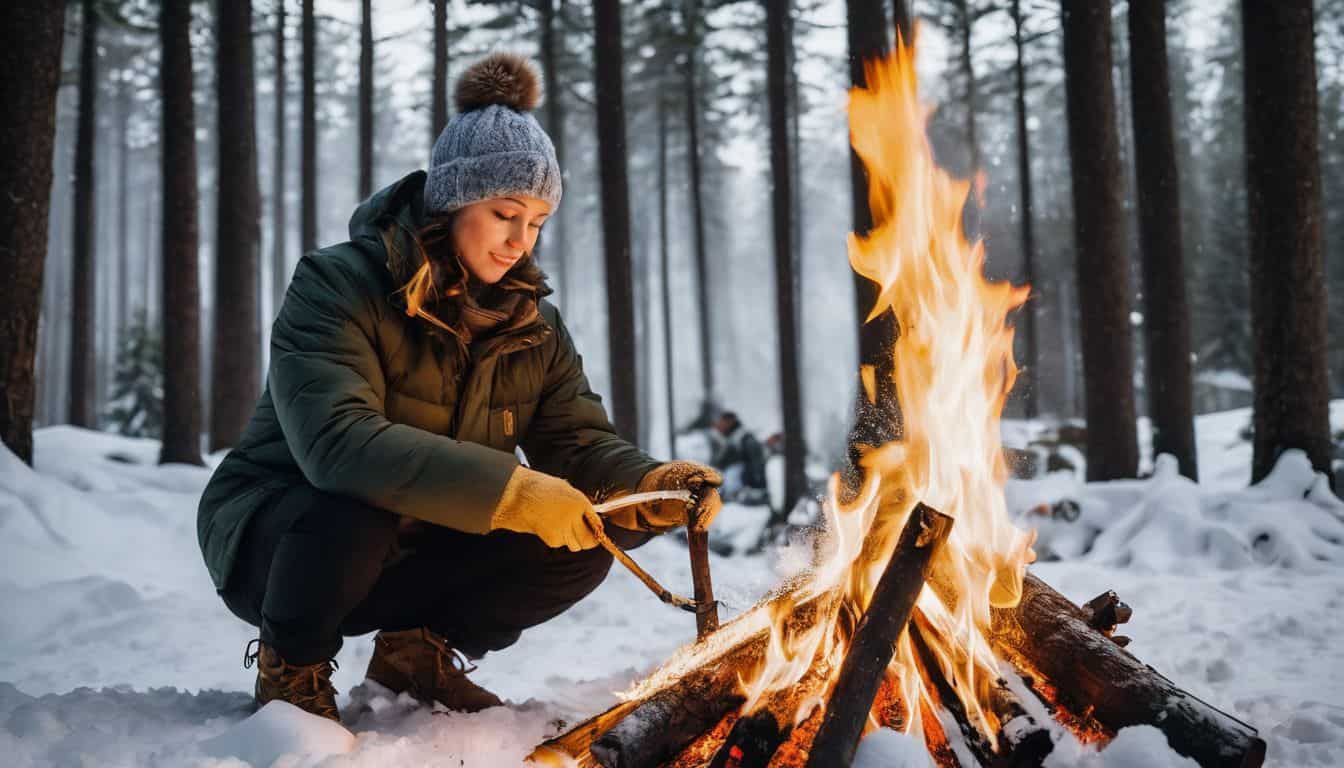Preserving meat in the wilderness is a challenge that could put Bear Grylls to the test. As a self-proclaimed survival devotee, I’ve had my fair share of wrestling with this predicament – probably more frequently than most people change their socks! But hey, perseverance leads to discovery right? After countless trials and extensive research (not all successful, I might add), I’ve nailed down some foolproof techniques for preserving meat while off-grid.
In this article, we’ll delve into seven tried-and-true methods that haven’t just saved my rations time and again (and yes, that includes bacon), but could also come to your rescue when you’re out embracing Mother Nature.
So buckle up and prepare for an adventure; let’s transform you into a gourmet survivalist who’s always ready to whip up something tasty no matter where you pitch your tent!
Key Takeaways
- Preserving meat in the wilderness is important to prevent spoilage and foodborne illnesses from bacteria growth.
- There are several effective methods for preserving meat in the wild, including sun drying, curing and corning, pickling, smoking, freezing, burying, and making preservation food or confit.
- Preserved meat has benefits such as prolonged shelf – life, improved taste, increased safety and health benefits. It also reduces the need for constant maintenance.
What Happens When We Don’t Preserve Meat

Not preserving meat can cause problems. Bacteria grow fast on raw meat. This leads to spoilage and a bad smell. It doesn’t even look good after a while! If we eat this spoiled meat, we can get sick.
This is not just about feeling ill for a day or two. Foodborne illnesses from bacteria in spoiled meat are serious stuff. They can make us very sick for a long time or worse, lead to death.
The other risk comes from cross-contamination. This happens when germs move from one food to another. For example, cutting raw meat on a board and then using the same board for vegetables without washing it.
So, it’s clear why we should preserve our meat right away! Freezing is an easy way when you’re out in nature with no fridge around.
But there are many other methods too like curing and smoking, drying, corning or making sausage of game meats.
Understanding the Basics of Preserving Meat in the Wilderness
In the wild, keeping meat fresh can be a challenge. We have to safeguard it from bacteria and other dangers that spoil food. Cross-contamination prevention is key here. Touching raw meat and then touching cooked one is a big no! Another way to keep meat safe in the wilderness is by using a cooler for perishable items.
A good cooler keeps your food cold and safe for days on end.
But what if you want your meat to last longer? There are ways for long-term food storage as well! You can try canning, drying, or freezing the meat. Canning involves sealing your food inside an air-tight jar after cooking it.
The process kills all bacteria which helps make the food safe for long periods of time.
Then there’s drying; removing all water from the meat stops bacterial growth. Remember not to over-dry though as it will make eating tough later on! And when you freeze your meats, keep them at very low temperatures.
This also slows down bacterial growth greatly.
Another great method I know about preserving meats in the wild is smoking them up nice and slow over wood fires made from hickory or applewood trees – both add fantastic flavour too while helping preserve it better!
To sum up: Keep things clean with cross-contamination prevention techniques; seal foods tight in cans; dry out all water content; freeze at super low temps..or just smoke everything away beautifully! All these basics help us win big time when we’ve got meats in hand but only wilderness around!
Nine Ways to Preserve Meat in the Wilderness
Preserving meat in the wilderness is crucial for survival. In this section, we will explore nine effective methods to keep your meat fresh and safe without refrigeration. From sunlight to smoking, these techniques will ensure you have a steady food supply in the wild.
Don’t miss out on these essential tips!
Sunlight
You can use sunlight to keep your meat safe in the wild. It is one of the nine ways to preserve meat outdoors. The sun dries up the meat and helps prevent bad bugs from growing on it.
This method is called sun drying, where the heat from the sun removes moisture from the meat. No wetness means bad bugs won’t like it! You need clear skies for this method though, so check your weather before starting.
Plus, you should slice your meat thin for quicker results with sun curing.
Curing and Corning
Curing and corning are traditional ways to preserve meat. They have been used for a long time, even before modern refrigeration. Curing involves removing or reducing moisture from the meat, which helps prevent bacteria from growing.
Corning, on the other hand, is a method that originated in Anglo-Saxon cultures and involves dry salting the meat. Both methods help improve the safety of the meat and make it last longer.
So if you’re out in the wilderness and need to preserve your meat, curing and corning are great options to consider.
Pickling
One of the ways to preserve meat in the wilderness is by pickling. Pickling can be done with artery-pumped meats, like sausages or bacon, by rubbing them with a dry cure mix or placing them in a pickle solution for about 5-7 days.
It’s not just limited to meats though; fish can also be pickled for preservation. In fact, homestead meat curing often uses traditional methods that include pickling to add flavor and preserve game meats.
So if you’re out in the wild and want to prolong the shelf-life of your meat while adding some tasty tanginess, give pickling a try!
Smoking
Smoking is a popular way to preserve meat when you don’t have a refrigerator. It’s all about using smoke from burning wood to keep the meat fresh for longer. When you smoke meat, the chemicals in the smoke act as natural preservatives.
Smoking also adds a delicious flavor to large cuts of meat and helps to keep them tender. To properly smoke and preserve your meat, it can take up to 8 hours, so make sure you plan ahead.
Freezing
When you’re out in the wilderness and refrigeration isn’t an option, freezing is a great way to preserve your meat. It’s simple and effective. Plus, it can help keep your wild game or poultry fresh for longer periods of time.
Did you know that frozen wild game can last up to one year without sacrificing quality? That’s pretty impressive! And if you’re making jerky, storing it in the freezer can extend its shelf life too.
To make sure your meat stays in top shape, consider using vacuum sealing as well. This popular method helps preserve game meats and fish by removing excess air from the packaging. So when it comes to preserving meat in the wild, freezing is definitely a technique worth considering!
Burying
Burying food is an ancient method of preserving meat in the wilderness. By burying meat underground or in the snow, we can keep it cool and extend its shelf-life. Burying is one of the nine ways mentioned in our article “Nine Ways to Preserve Meat in the Wilderness.” It’s an effective method for survival enthusiasts looking to preserve their food when out in the wild.
Along with burying, you’ll also find other methods like using sunlight, curing and corning, pickling, smoking, freezing, and using curing salt for meat preservation. So if you’re out there exploring nature and need a way to keep your meat fresh without any fancy equipment, give burying a try!
Making Preservation Food
One of the important ways to preserve meat in the wilderness is by making preservation food. This method involves creating a mixture of cooked meat, fat, and spices that can be stored without refrigeration.
By cooking the meat and combining it with fat, you create an environment where bacteria cannot thrive. The addition of spices not only adds flavor but also has antimicrobial properties that further protect the meat from spoilage.
This preservation food can be sealed in containers or wrapped tightly in butcher paper for long-term storage. It’s a practical option for ensuring you have a source of protein in survival situations, as it extends the shelf-life of your meat and keeps it safe to consume.

Making a Confit
Making a confit is a great way to preserve meat in the wilderness. You can use this method for duck, goose, or pork. It involves salting the meat and cooking it slowly in fat until it becomes tender and full of flavor.
Traditionally, duck or goose legs were heavily salted, seasoned with herbs, and then cooked in duck fat to make confit. The key is to make sure you salt the meat well and cook it at a low temperature for a long time.
This process helps to preserve the meat while also bringing out its delicious taste. So if you’re looking for a tasty and effective way to preserve your meat in the wild, making a confit is definitely worth trying.
Rendering Fat
Rendering fat is an essential step in preserving meat, especially when making pemmican. To render fat, you need to cut animal fat into one-inch cubes and remove any visible meat, veins, or non-fatty tissue.
This process helps purify the fat by separating it from any blood, connective tissue, water, or meat. It’s important to note that lard is not bad for you and can actually be a source of healthy fats when used in moderation.
For example, squirrel fat can be rendered by boiling it until the water evaporates. Once the liquid fat cools down, you can store it in a sealable plastic bag and freeze it for up to 9 months.
Benefits of Preserving Meat
Preserving meat offers several benefits including prolonged shelf-life, improved taste, increased safety and health benefits, and reduced maintenance.
Prolonged shelf-life
Preserving meat in the wilderness has many benefits, one of them being prolonged shelf life. By using various preservation methods like curing, smoking, freezing, and pickling, the shelf life of meat can be extended significantly.
For example, vacuum-packaged fresh beef can last up to 35 to 45 days. Natural preservation techniques also help in keeping the meat fresh without compromising its taste or quality.
So whether you’re on a survival adventure or just want to enjoy your meat for longer periods, preserving it properly will ensure that it stays safe and delicious for as long as possible.
Improves taste
Preserving meat not only helps to prolong its shelf-life but also enhances its taste. By using methods like curing and corning, you can add delicious flavors to your meat. Curing ingredients such as nitrate and nitrite are essential for achieving the characteristic flavor of cured meat.
Smoking is another method that can give a unique smoky taste to your preserved meat. Whether you choose to smoke, cure, or use other preservation techniques, you’ll be able to enjoy flavorful and tasty meat even when living in the wild.
So why settle for bland food when you can preserve it and improve the taste at the same time?.
Increases safety and health benefits
Preserving meat in the wild doesn’t just keep it edible for longer, but it also brings safety and health benefits. When we preserve meat properly, we control spoilage by stopping the growth of harmful microorganisms.
This means that the chances of getting sick from contaminated meat are reduced. Additionally, preservation techniques like canning, drying, and freezing slow down enzymatic reactions and prevent fatty acid oxidation, which helps maintain the nutritional value of the meat while extending its shelf life.
So not only does preserving meat in the wild ensure a sustainable source of food, but it also keeps us safe and healthy in survival situations.
Reduced maintenance
Preserving meat in the wild using methods like curing, smoking, and drying can help reduce the need for constant upkeep. Unlike refrigerated storage, which typically only keeps fresh meats good for about 5 to 7 days, these preservation techniques can extend the shelf life of your meat and make it last longer without needing special care.
This means less time spent worrying about spoilage or constantly checking on your preserved meats. So if you’re looking for a way to maintain your meat supply with minimal maintenance required, these preservation methods are definitely worth considering.
How to Choose the Right Method
To choose the right method for preserving meat in the wilderness, consider the type of meat, identify contaminants, and think about filter capacity and replacement frequency. Read more to learn how to make sure your meat stays fresh and safe in any outdoor adventure.
Determine the type of meat
To preserve meat in the wilderness, it’s important to first determine the type of meat you’re working with. Different types of meat require different preservation methods. For example, wild game meats like deer or elk may need specific techniques compared to poultry or store-bought cuts.
Knowing the type of meat will help you choose the right preservation method and ensure its freshness and quality for longer periods. So, take a moment to identify the kind of meat you have before deciding on how to preserve it in the wild.
Keep in mind that each type might have unique characteristics that affect its shelf-life and how it should be preserved. For instance, chicken is a protein-rich meat with low fat content, making it more susceptible to spoilage if not properly stored or processed.
Identify the contaminants
When preserving meat in the wild, it is important to identify any contaminants that may be present. Contaminants can include bacteria, mold, and parasites that can make you sick if consumed.
To ensure the safety of the preserved meat, carefully inspect it for any signs of spoilage such as an off smell or unusual color. Additionally, check for any visible signs of contamination such as mold growth or insect infestation.
It’s crucial to prioritize food safety when preserving meat in the wilderness to avoid potential health risks associated with consuming contaminated meat.
Consider filter capacity and replacement frequency
When choosing the right method to preserve meat in the wilderness, it’s important to consider the filter capacity and replacement frequency. This means you need to think about how much meat you’re planning to preserve and how often you’ll need to replace or clean your filters.
Different preservation methods have different requirements, so it’s essential to choose one that suits your needs and resources. By considering these factors, you can ensure that your meat is preserved effectively for long-term storage in the wild.
Drying
To dry meat in the wilderness, you can use direct sunlight or a drying rack to remove moisture and create jerky-like strips that are lightweight and easy to store.
Use of direct sunlight
The use of direct sunlight is one of the oldest and simplest methods to preserve meat in the wild. Native Americans, especially those who hunted buffalo, used sun drying as a traditional method to preserve their food.
This method still works efficiently in areas with strong sunlight and low humidity. By exposing the meat to the sun’s heat, it helps remove moisture from the meat, which slows down bacterial growth and spoilage.
Sun drying is a cost-effective way to preserve meat without needing refrigeration equipment.
Using a drying rack
I love using a drying rack to preserve meat in the wilderness. It’s such a handy tool! The drying rack can hold up to 7 pieces of meat at a time, making it efficient for preserving larger quantities.
By using a drying rack, I can improve the safety and effectiveness of meat drying, reducing any chance of food waste. When using a drying rack, it’s important to use lean meat for better preservation results.
Removing excess fat before placing the meat on the rack helps ensure successful drying. If you’re feeling adventurous, you can even build your own DIY dry curing chamber with controllers that regulate humidity and temperature for dry-cured meat – how cool is that?.
Salting or Curing
To preserve meat in the wild, salting or curing is an effective method using salt, sugar, and nitrates. Store the cured meat in an area with good air circulation to ensure proper drying and preservation.
Salting or curing with salt, sugar, and nitrates
When it comes to preserving meat in the wilderness, salting or curing with salt, sugar, and nitrates is a popular method. Curing involves adding a mixture of salt, nitrites (like pink curing salt), and sometimes sugar to the meat.
This process helps to prevent bacterial growth and extend the shelf life of the meat. It also adds flavor and enhances the texture of the meat. However, it’s important to note that curing salts should be used in moderation as they can be toxic in large quantities.
To effectively preserve meat using this method, you’ll need to ensure good air circulation during storage for optimum results.
Store in an area with good air circulation
To ensure the proper preservation of meat in the wild, it is crucial to store it in an area with good air circulation. This is especially important when it comes to salted or cured meat.
Good air circulation helps to prevent the growth of bacteria and mold, which can spoil the meat and make it unsafe to eat. When storing salted or cured meat, find a spot that allows air to flow freely around the meat.
This could mean using a drying rack or hanging the meat in a place where there is a gentle breeze. By ensuring good air circulation, you can help maintain the quality and freshness of your preserved meat for longer periods of time, even in challenging wilderness conditions.
Smoking
Smoking is another effective method for preserving meat in the wilderness by using smoke to dry and flavor the meat, helping to extend its shelf life.
Use of smoke for preservation
Smoking is a great way to preserve meat in the wild. When we smoke meat, it kills microbes and acts as a preservative, helping it last longer without spoiling. This method involves exposing cured meat and fish to smoke, which gives them a unique flavor while also preserving them.
Cold smoking methods, like using salt cure, are commonly used for this purpose. Smoking was even used before refrigeration was invented as a way to keep meat from going bad. So if you’re trying to preserve your food in the wilderness, smoking is definitely worth considering!
Different types of wood
When it comes to smoking meat in the wilderness, using different types of wood can make a big difference in flavor. Some popular choices include hickory, oak, maple, mesquite, pecan, black walnut, apple, mulberry, and cherry.
Each type of wood provides a unique taste to the meat being smoked. For example, hickory is great for ribs and pork while maple is versatile and can be used with various meats like chicken and brisket.
It’s important to experiment with different types and sizes of wood to find the perfect combination that enhances the flavor of your smoked meat.
Hot and cold smoking
Hot and cold smoking are two different methods used for preserving meat. In hot smoking, the meat is cooked while being exposed to smoke, which gives it a delicious smoky flavor. This method is great for cooking with smoke and enhancing the taste of the meat.
On the other hand, cold smoking involves placing the meat in a room temperature environment that is filled with smoke. This method is mainly used for curing meats and fish products, as it doesn’t cook them but instead imparts a smoky flavor and helps preserve them for longer periods of time.
Both hot and cold smoking can be used to make your preserved meats more flavorful and enjoyable to eat.
Freezing
To freeze meat in the wilderness, use dry ice or sealed plastic to create a cold environment. Ensure that the temperature range for storing the meat is ideal to prevent spoilage and maintain freshness.
Use of dry ice or sealed plastic
To preserve meat in the wild, one effective method is to use dry ice or sealed plastic. Dry ice can be used to transport wild game and minimize spoilage. It can also be used for flash freezing fish, which helps maintain its freshness.
Sealing the meat in plastic can prevent air and moisture from entering, keeping it preserved for longer periods. These methods are particularly useful when refrigeration is not available or limited in remote areas.
By using dry ice or sealed plastic, you can ensure that your meat stays fresh and safe to eat while exploring the wilderness.
Ideal temperature range for storing meat
To keep meat fresh and safe for consumption, it’s important to store it at the right temperature. When freezing meat, the ideal temperature range is 0°F (-18°C) or below. This low temperature slows down the growth of bacteria, keeping your food safe.
If stored continuously at this temperature, frozen meat can be kept indefinitely. Refrigerated meats should be stored at a slightly higher temperature of 33°F to 36°F (1°C to 2°C).
By storing your meat within these recommended ranges, you can ensure its quality and safety for longer periods of time.
Conclusion on Preserving Meat in The Wild
In conclusion, preserving meat in the wild is essential for survival and ensuring food sustainability. By using techniques like sunlight preservation, curing and corning, pickling, smoking, freezing, sugaring, salt curing, drying in the sun, and even burying the meat, you can prolong its shelf-life and improve taste.
These methods allow you to enjoy wild game while minimizing waste and increasing your chances of survival in extreme conditions. So remember these 7 ways to win when it comes to preserving meat in the wild!
FAQs on Preserving Meat in The Wild
1. How can I preserve meat in the wild without refrigeration?
You can preserve meat in the wild without refrigeration by smoking it, drying it, or using natural preservatives like salt.
2. What is the best way to smoke meat for preservation?
The best way to smoke meat for preservation is to build a fire and hang the meat above it, allowing the smoke to penetrate and dry out the meat.
3. Can I use salt to preserve meat in the wild?
Yes, you can use salt as a natural preservative for curing meats. Rubbing salt on the surface of the meat helps draw out moisture and inhibit bacterial growth.
4. How long does dried meat last in the wild?
Dried meat can last several months or even years if properly prepared and stored in an airtight container.
5. Are there any risks involved with preserving meat in the wild?
There are some risks involved with preserving meat in the wild, such as contamination from bacteria or insects. It’s crucial to handle and store preserved meats properly to avoid foodborne illnesses.





Leave a Reply